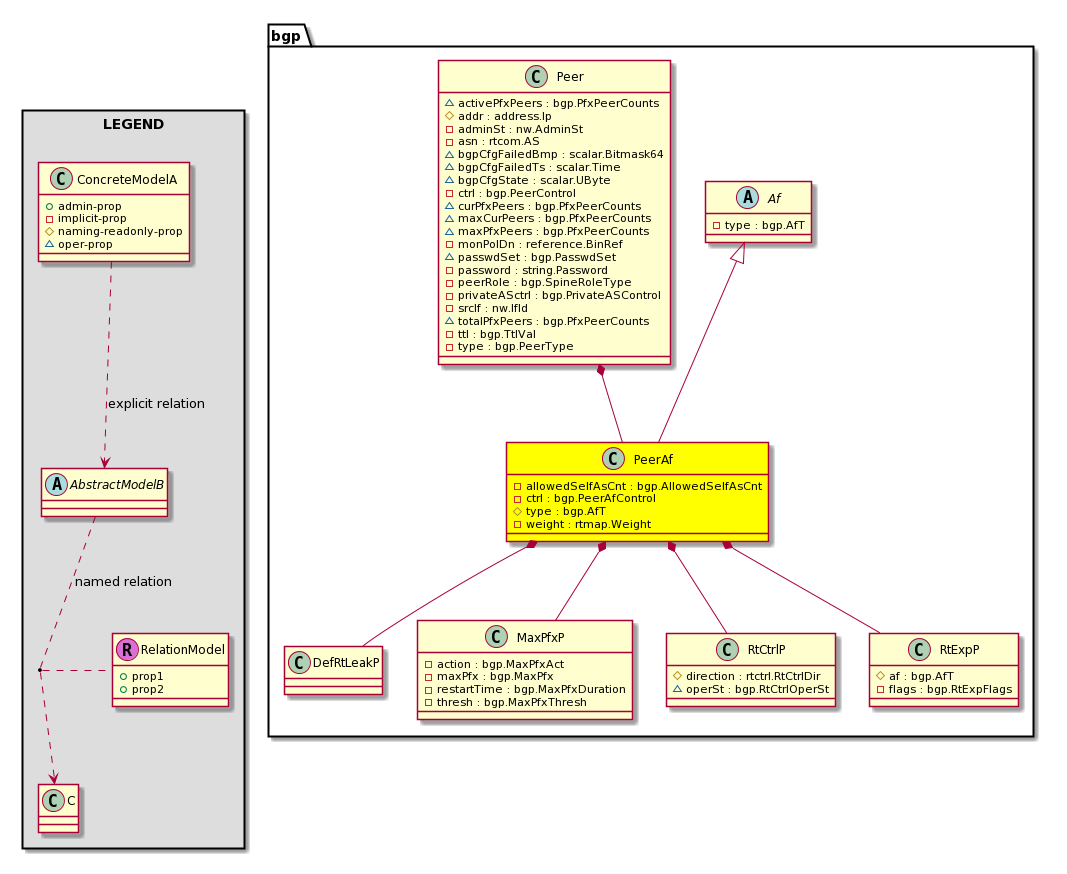| Properties Summary |
| Defined in: mo:Resolvable |
mo:Owner
scalar:Enum8
|
lcOwn (mo:Resolvable:lcOwn)
A value that indicates how this object was created. For internal use only.
|
allowedSelfAsCnt
Type: bgp:AllowedSelfAsCnt
Primitive Type: scalar:Uint16
Units: null
Encrypted: false
Access: implicit
Category: TopLevelRegular
Comments:
-
The number of occurrences of a local Autonomous System Number (ASN).
| |
| Constants |
| defaultValue |
3 |
--- |
NO COMMENTS
|
|
childAction
Type: mo:ModificationChildAction
Primitive Type: scalar:Bitmask32
Units: null
Encrypted: false
Access: implicit
Category: TopLevelChildAction
Comments:
-
Delete or ignore. For internal use only.
| |
| Constants |
| deleteAll |
16384u |
deleteAll |
NO COMMENTS
|
| ignore |
4096u |
ignore |
NO COMMENTS
|
| deleteNonPresent |
8192u |
deleteNonPresent |
NO COMMENTS
|
| DEFAULT |
0 |
--- |
This type is used to
|
|
ctrl
Type: bgp:PeerAfControl
Primitive Type: scalar:Bitmask8
Units: null
Encrypted: false
Access: implicit
Category: TopLevelRegular
Comments:
-
The peer controls specify which Border Gateway Protocol (BGP) attributes are sent to a peer.
| |
| Constants |
| send-com |
1 |
Send Community |
Send community
|
| send-ext-com |
2 |
Send Extended Community |
Send extended community
|
| rr-client |
4 |
Route Reflector Client |
Router reflector client
|
| nh-self |
8 |
Next-hop Self |
Nexthop self
|
| dis-peer-as-check |
16 |
Disable Peer AS Check |
Disable checking of peer AS number while advertising
|
| allow-self-as |
32 |
Allow Self AS |
Allows local AS number in the AS path
|
| as-override |
64 |
As Override |
Overrides AS number of originating router to that of
sending BGP router
|
| DEFAULT |
0 |
--- |
Peer Address Family Control
|
|
dn
Type: reference:BinRef
Units: null
Encrypted: false
Access: implicit
Category: TopLevelDn
Comments:
-
A tag or metadata is a non-hierarchical keyword or term assigned to the fabric module.
lcOwn
Type: mo:Owner
Primitive Type: scalar:Enum8
Units: null
Encrypted: false
Access: implicit
Category: TopLevelRegular
Comments:
-
A value that indicates how this object was created. For internal use only.
| |
| Constants |
| local |
0 |
Local |
NO COMMENTS
|
| policy |
1 |
Policy |
NO COMMENTS
|
| replica |
2 |
Replica |
NO COMMENTS
|
| resolveOnBehalf |
3 |
ResolvedOnBehalf |
NO COMMENTS
|
| implicit |
4 |
Implicit |
NO COMMENTS
|
| DEFAULT |
local(0) |
Local |
NO COMMENTS
|
|
modTs
Type: mo:TStamp
Primitive Type: scalar:Date
Units: null
Encrypted: false
Access: implicit
Category: TopLevelRegular
Comments:
-
The time when this object was last modified.
| |
| Constants |
| never |
0ull |
never |
NO COMMENTS
|
| DEFAULT |
never(0ull) |
never |
NO COMMENTS
|
|
name
Type: naming:Name
Primitive Type: string:Basic
Overrides:nw:Conn:name
Units: null
Encrypted: false
Access: admin
Category: TopLevelRegular
Comments:
-
The name of the object.
rn
Type: reference:BinRN
Units: null
Encrypted: false
Access: implicit
Category: TopLevelRn
Comments:
-
Identifies an object from its siblings within the context of its parent object. The distinguished name contains a sequence of relative names.
status
Type: mo:ModificationStatus
Primitive Type: scalar:Bitmask32
Units: null
Encrypted: false
Access: implicit
Category: TopLevelStatus
Comments:
-
The upgrade status. This property is for internal use only.
| |
| Constants |
| created |
2u |
created |
In a setter method: specifies that an object should be created.
An error is returned if the object already exists.
In the return value of a setter method: indicates that an object has been created.
|
| modified |
4u |
modified |
In a setter method: specifies that an object should be modified
In the return value of a setter method: indicates that an object has been modified.
|
| deleted |
8u |
deleted |
In a setter method: specifies that an object should be deleted.
In the return value of a setter method: indicates that an object has been deleted.
|
| DEFAULT |
0 |
--- |
This type controls the life cycle of objects passed in the XML API.
When used in a setter method (such as configConfMo), the ModificationStatus
specifies whether an object should be created, modified, deleted or removed.
In the return value of a setter method, the ModificationStatus indicates the actual
operation that was performed. For example, the ModificationStatus is set to "created"
if the object was created. The ModificationStatus is not set if the object was neither
created, modified, deleted or removed.
When invoking a setter method, the ModificationStatus is optional:
If a setter method such as configConfMo is invoked and the ModificationStatus
is not set, the system automatically determines if the object should be created or modified.
|
|
type
Type: bgp:AfT
Primitive Type: scalar:Enum8
Overrides:bgp:Af:type
Units: null
Encrypted: false
Naming Property -- [NAMING RULES]
Access: naming
Category: TopLevelRegular
Comments:
-
null
| |
| Constants |
| ipv4-ucast |
1 |
IPv4 unicast address family |
ipv4 unicast
|
| vpnv4-ucast |
2 |
Vpnv4 unicast address family |
vpnv4 unicast
|
| ipv6-ucast |
3 |
IPv6 unicast address family |
ipv6 unicast
|
| vpnv6-ucast |
4 |
Vpnv6 unicast address family |
vpnv6 unicast
|
| l2vpn-evpn |
5 |
L2Vpn EVpn address family |
l2vpn evpn
|
| rtfilter-ucast |
6 |
Route target filter address family |
rtfilter unicast
|
| DEFAULT |
ipv4-ucast(1) |
IPv4 unicast address family |
ipv4 unicast
|
|
weight
Type: rtmap:Weight
Primitive Type: scalar:Uint16
Units: null
Encrypted: false
Access: implicit
Category: TopLevelRegular
Comments:
-
The weight of the fault in calculating the health score of an object. A higher weight causes a higher degradation of the health score of the affected object.

